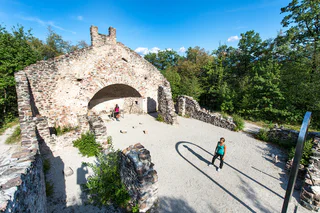
Crossing cycling trail Neumarkt/Egna
Mazzon/Mazon, Neumarkt/Egna, Alto Adige Wine Road
| Plongez dans l'histoire et la culture de la Route des Vins du Tyrol du Sud. Visitez des sites emblématiques et découvrez le riche patrimoine viticole de la région. |

Mazzon/Mazon, Neumarkt/Egna, Alto Adige Wine Road

Cauria/Gfrill, Salorno/Salurn, Alto Adige Wine Road

1/2
Castelvecchio/Altenburg, Kaltern an der Weinstraße/Caldaro sulla Strada del Vino, Alto Adige Wine Road

1/3
Andriano/Andrian, Andrian/Andriano, Alto Adige Wine Road

Gleno/Glen, Montan/Montagna, Alto Adige Wine Road

1/7
Gaido/Gaid, Eppan an der Weinstaße/Appiano sulla Strada del Vino, Alto Adige Wine Road

1/2
Tramin an der Weinstraße/Termeno sulla Strada del Vino, Alto Adige Wine Road

1/3
Pinzano/Pinzon, Montan/Montagna, Alto Adige Wine Road

1/4
Magrè s.S.d.V./Margreid a.d.W., Margreid an der Weinstraße/Magrè sulla Strada del Vino, Alto Adige Wine Road

Favogna di Sotto/Unterfennberg, Margreid an der Weinstraße/Magrè sulla Strada del Vino, Alto Adige Wine Road

Egna/Neumarkt, Neumarkt/Egna, Alto Adige Wine Road

1/8
S. Giuseppe al Lago/St. Josef am See, Kaltern an der Weinstraße/Caldaro sulla Strada del Vino, Alto Adige Wine Road

1/3
Pinzano/Pinzon, Montan/Montagna, Alto Adige Wine Road

1/3
Pinzano/Pinzon, Montan/Montagna, Alto Adige Wine Road

Montagna/Montan, Montan/Montagna, Alto Adige Wine Road

1/3
Appiano Monte/Eppan Berg, Eppan an der Weinstaße/Appiano sulla Strada del Vino, Alto Adige Wine Road

S. Paolo/St. Pauls - Appiano/Eppan, Eppan an der Weinstaße/Appiano sulla Strada del Vino, Alto Adige Wine Road

Ora/Auer, Auer/Ora, Alto Adige Wine Road

1/4
Terlano/Terlan, Terlan/Terlano, Alto Adige Wine Road

Tramin an der Weinstraße/Termeno sulla Strada del Vino, Alto Adige Wine Road

1/3
Cornaiano/Girlan, Eppan an der Weinstaße/Appiano sulla Strada del Vino, Alto Adige Wine Road

1/3
Andriano/Andrian, Andrian/Andriano, Alto Adige Wine Road

Tramin an der Weinstraße/Termeno sulla Strada del Vino, Alto Adige Wine Road

Terlano/Terlan, Terlan/Terlano, Alto Adige Wine Road

1/2
Tramin an der Weinstraße/Termeno sulla Strada del Vino, Alto Adige Wine Road

1/3
Pinzano/Pinzon, Auer/Ora, Alto Adige Wine Road

S. Michele/St. Michael - Appiano/Eppan, Eppan an der Weinstaße/Appiano sulla Strada del Vino, Alto Adige Wine Road

1/3
S. Nicolò/St. Nikolaus - Caldaro/Kaltern, Kaltern an der Weinstraße/Caldaro sulla Strada del Vino, Alto Adige Wine Road

1/2
S. Michele/St. Michael - Appiano/Eppan, Eppan an der Weinstaße/Appiano sulla Strada del Vino, Alto Adige Wine Road

Ora/Auer, Auer/Ora, Alto Adige Wine Road